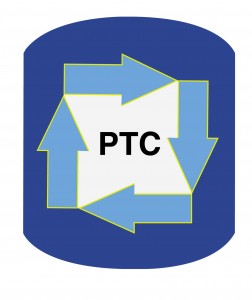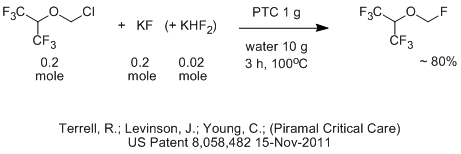US Patent 8,058,482 describes the nucleophilic aliphatic fluoride-chloride exchange on a chloromethyl ether. As noted in the Nov 2011 PTC Tip of the Month, the use of too little water reduced reactivity. The use of too much water also reduces reactivity while promoting hydrolysis of the chloromethyl ether to hydroxymethyl ether.
It is quite interesting that under similar conditions, the same weight of various catalysts gave the same yield in the range of 78-81%. These catalysts included the thermally stable HTA-1 and the normally unstable triethyl benzyl ammonium chloride that decomposes by both nucleophilic substitution and Hofmann Elimination by the strong fluoride base. I speculate (but do not know) that maybe the quats are decomposing to trialkylamine and they quaternize in-situ with the chloromethyl ether starting material to form a new quat that can decompose into the desired product if attacked by more fluoride.
An important practical note is that the reactions that combined the use of 10 mol% KHF2 with 1 equiv of KF did better than those that used 1.1 equiv KF.
The patent describes many combinations of water level, phase-transfer catalysts (including Aliquat 336, TBAB and even tetraethyl ammonium chloride) and mole ratios of KF/KHF2 to starting material. If you read the patent, note that the actual yield is really the conversion reported multiplied by the yield reported. In any case, this patent reports a surprisingly high number of experiments (46) that show how the process parameters interact with each other.
If you or your company can benefit from achieving higher process performance in a shorter development time for this PTC reaction or any other reaction, by having access to the best PTC expertise available, NOW CONTACT Marc Halpern to inquire about using phase-transfer catalysis to achieve low-cost high-performance green chemistry. Remember, PTC excels in thousands of reactions in more than 30 reaction categories including strong base reactions, nucleophilic substitutions, oxidations and reductions.
If you’re not sure if PTC can help your reaction, now fill out the PTC Project Evaluation Form and E-mail a scanned copy to Marc Halpern or send it by fax to Dr. Halpern at +1 856-222-1124. If your company does not have a secrecy agreement with PTC Organics Inc. already in place, please use “R-groups” instead of the exact chemical structures.


